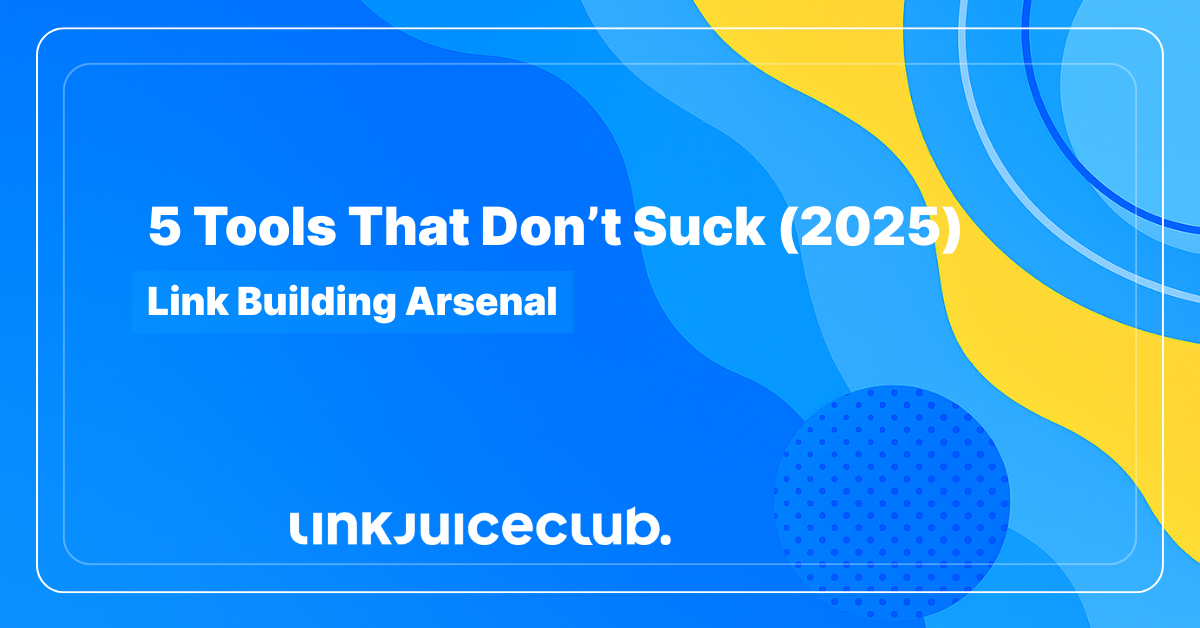
Link Building Arsenal: 5 Link Building Tools That Don’t Suck (2025)
You’ve probably already seen blog posts with titles like “Top Link Building Tools of 2025!” They all look the same: a bunch of tool descriptions lifted straight from the company’s own website, tossed into a list like it’s a salad of mediocrity. That’s not what we’re doing here.
This is for people who actually need to rank. As in: move up the search results, build authority, and maybe not lose sleep over whether Google’s ignoring your 15th guest post this month.
So, what’s the real purpose of this list?
We’re spotlighting the tools that do four things:
- Actually help you rank better (not just feel like you’re doing something useful).
- Justify their monthly subscription costs.
- Work like a charm whether you’re using them solo or as part of a stack.
- Avoid making you throw your keyboard in frustration because they’re clunky or useless at scale.
When a tool’s main talent is sending one outreach email every full moon or starts coughing when you ask it to pull 500 prospects, it’s out. This isn’t summer camp, no one’s handing out ribbons for “trying hard.”
What you’re getting instead is a lean lineup of the five best tools for link building in 2025, which is stuff we actually use, stuff that actually works, and tools that don’t implode when you try to automate a campaign or run a proper digital PR push.
And we’re starting with the one that’s so obvious, leaving it out would basically be SEO malpractice.
Shall we?
1. SEMRush (2025): The Jack-of-All-Trades 🃏
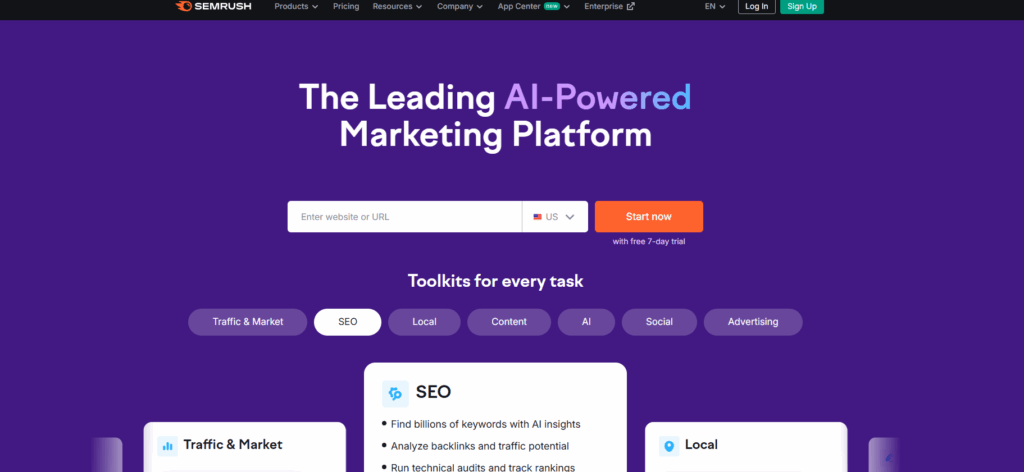
Imagine if your neighbor won the lottery, bought a gym, a newspaper, a drone company, and then decided he’s now a one-stop shop for everything. That’s SEMRush. It started out focused, then went public and got loaded, and now wants to be your SEO tracker, content coach, backlink analyst, social media manager, domain profiler, and probably your therapist too if you click far enough into the dashboard.
Is it too much? Perhaps.
SEMRush gives you a buffet of features, with more tabs than a 2003 browser window. But tucked inside this all-in-one digital toolbox is a set of link building tools that when used with a bit of finesse, deliver far more impact than most give them credit for.
And yes, despite being cheaper than most premium SEO suites at the top tiers, it doesn’t feel like a downgrade. At least not in the backlink department.
The Link Building Tool (That’s the Actual Name)
Now here’s the gem hiding in SEMRush’s sea of buttons and graphs: the actual Link Building Tool. The name’s as boring as a tax form, but the functionality is anything but dull.
Here’s how it works, in plain speak:
You give SEMRush your site and a handful of keywords. It then snoops around your niche’s SERPs and finds link prospects by scraping who’s linking to the competition. From there, it pulls contact info via its data partners, gives you editable outreach templates (surprisingly tolerable), and even slots everything into an email sequence.
Bonus: SEMRush cleans house automatically. If a link is already in your profile or goes missing, it takes it off your prospect list without you having to do a thing. That’s what I call CRM hygiene without the headache.
Backlink Gap Tool: The Competitive Smackdown
Here’s where SEMRush plays it smart. Instead of drowning you in link data like Ahrefs, it gives you direction. The Backlink Gap feature is dead simple and deadly useful.
Pop in three to five of your rivals. SEMRush then reveals every domain sending links their way while skipping over yours. It sorts this goldmine by authority, traffic, follow/nofollow, and type of link. It’s like discovering your competitors have been invited to every party in town, and you’re still waiting by the mailbox.
You can see it in action below: the comparison table lines up your competitors and spits out the exact referring domains you’re missing.
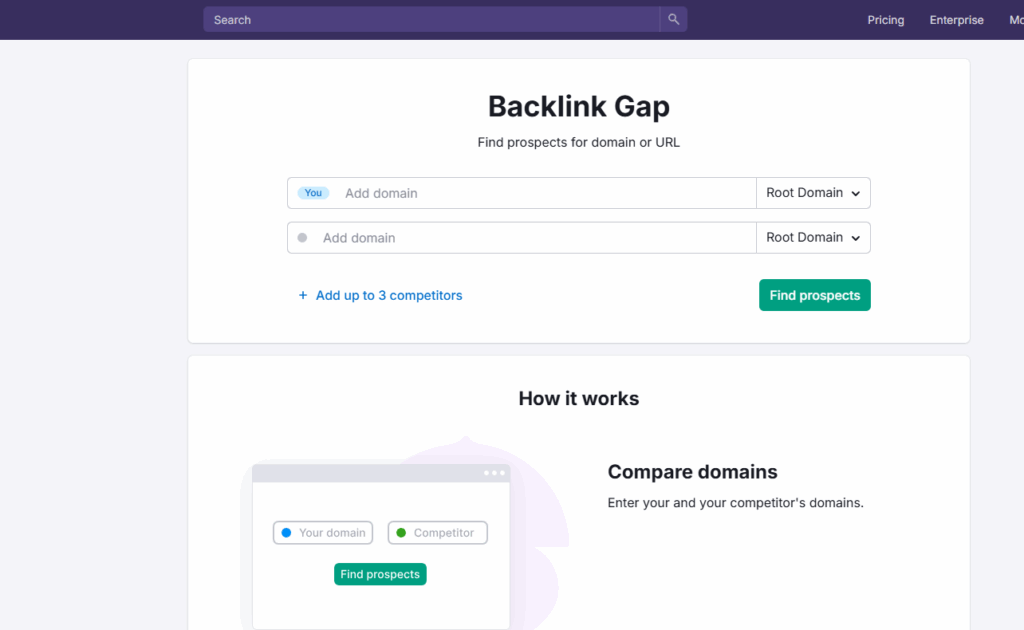
Even better? You can drop those prospects straight into the Link Building Tool without juggling spreadsheets. That’s outreach automation riding shotgun with your research.
Risky Link Monitoring: Because Clients Like Scary Charts
Now, Google isn’t sending people to the dungeon for sketchy backlinks anymore (not unless you’ve really gone off the rails), but SEMRush still offers a link audit with a “toxicity score.” It flags spammy domains, dodgy anchor text, and shady patterns that might raise eyebrows.
Should you disavow these links? Probably not. But when it comes to showing clients something dramatic? Oh, it looks fantastic. SEMRush even spits out a ready-to-upload disavow file, just don’t expect it to be your silver bullet.
It’s link theatre, but polished and convincing.
Where SEMRush Trips Over Its Own Shoes
While SEMRush brings a lot to the table for link builders, no tool is without its quirks. Here are a few areas where it shows some growing edges, not dealbreakers though, but good to keep in mind:
- Database Coverage Can Vary
For mainstream topics and competitive niches, it does a solid job. But if you’re working in hyper-niche verticals or targeting smaller regions, you might notice lighter coverage compared to tools like Ahrefs. - Contact Info Isn’t Always Spot-On
SEMRush pulls email data through its partnerships, which works well enough for many cases. Still, for those who want extra precision, pairing it with a dedicated contact scraper like Hunter.io might be a smart move. - Feature Set Is… Ambitious
It offers a massive toolbox, which is great if you love options, but can take a little time to fully navigate. Once you find your groove though, it’s surprisingly efficient. - Focus is Broad, Not Narrow
SEMRush aims to be an all-in-one platform. That’s a strength for many users, especially solo operators or small teams, but if you’re after a razor-sharp, purpose-built backlink tool, you may want to pair it with something more specialized.
So, Should You Use It?
If you’re looking for an all-in-one platform that handles link research, outreach, automation, and reporting from a single login, SEMRush is a solid bet. It’s clunky in parts, yes. But treat it like a multi-tool: use the blade, not the nail file.
It won’t replace everything. It’s not the king of backlink data. It’s not the god-tier outreach suite either.
If your goal is to build links without juggling five platforms, and you’re willing to click around until it makes sense, it delivers.
Just don’t expect it to brew your coffee or meditate your bounce rate away. SEMRush does a lot, but link building is where it actually does it well.
Pricing-wise, it runs between €134.95 and €499.95 per month. Most link builders will get the best value out of the mid-tier. Avoid the “Guru” plan unless you’re managing an army of projects. The entry-level plan is a bit too lean if link building is your main play.
2. Ahrefs (2025): The Sharpest Blade in the SEO Toolkit 🗡️
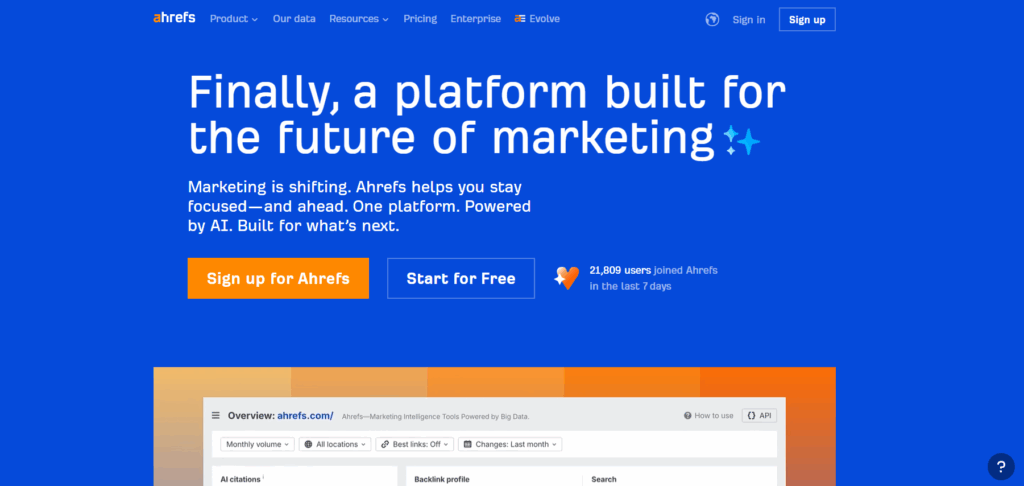
If SEMRush is your overachieving all-rounder, then Ahrefs is your reliable, no-nonsense operator with a serious eye for backlinks. This isn’t the tool that holds your hand. It throws you into the deep end and expects you to learn to swim. Fast.
That’s thanks to Ahrefs running the most extensive backlink index in the entire SEO space, which is why most serious campaigns start here. The sheer volume of data it throws at you can feel like being hit with a firehose, backlinks, keywords (paid and organic), domain metrics, SERP features, content stats, and every ratio chart imaginable.
If your site already has some history, the data can feel overwhelming. Once you move past the flinching and start filtering, it’s the kind of tool that makes other tools feel like toys.
What It Won’t Do (So You Don’t Waste Time Looking)
Despite its power, Ahrefs skips a few bells and whistles, by design or by stubbornness:
- No outreach features. You get the data, but don’t expect built-in email workflows or automated contact discovery. That’s someone else’s job.
- Rank tracking? Not its strong suit. It exists, but if daily SERP movement is your thing, use something dedicated like Wincher or SERPWoo.
- Integrations are oddly sparse. Considering its reputation, the API access is surprisingly restricted and it doesn’t come cheap.
- Tab-hoppers beware. The UX can feel sluggish when multitasking, especially during traffic-heavy hours, since it runs on a queued grid system.
Ahrefs’ Best Link Building Plays
Ahrefs offers plenty of clever tricks, but when it comes to return on effort, these two are the ones worth locking in on:
1. Reverse Engineer Competitor Links, But Do It Right
Most users type in a competitor’s domain, click “Backlinks,” and scroll aimlessly. Not you.
This is how you turn their top-performing pages into your next backlink targets:
- Jump into Top Pages, then sort by traffic.
You’ll see something like the view below; pages that are pulling serious weight in search and are ripe for backlink analysis.
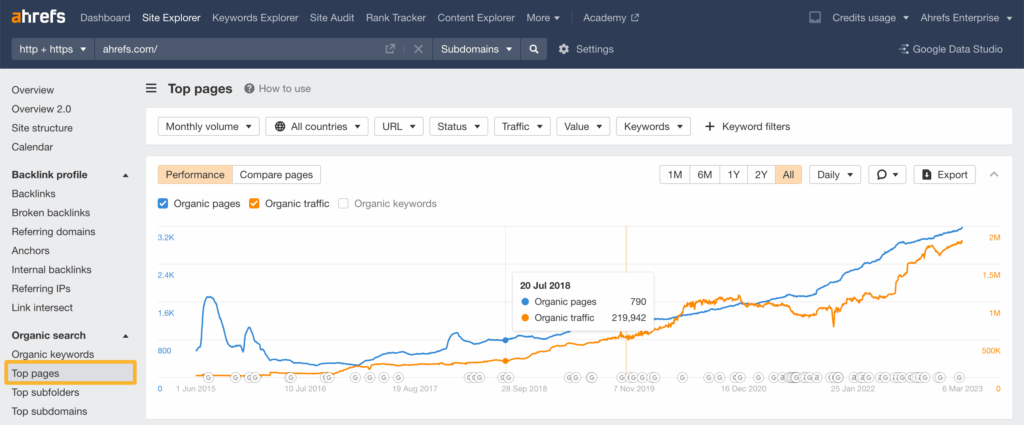
- Identify the first 5 to 50 high-traffic URLs, think purchase-ready or lead-driving terms.
- For each, pull their referring domains and backlinks.
- Repeat across competitors and log the results in your own sheet.
- Build outreach lists not just by site, but by page relevance.
This method surfaces context-rich, hyper-targeted prospects.
Bonus if you enable “One Link Per Domain” to cut through the noise faster and avoid duplicate digging.
2. Large-Scale Broken Link Building (Done Right)
Ahrefs’ Content Explorer isn’t just for finding articles. It’s a secret weapon for broken link building at scale.
Here’s how you wield it:
Start by searching for educational domains that mention outdated resources related to your niche, think along the lines of .edu sites referencing old or obsolete content in your field.
You can also phrase it more generally if you want to avoid any footprint-style syntax:
Begin by looking for academic pages in your niche that likely include broken or outdated external links, especially older resource lists or citation-heavy content.
So, Should You Use It?
If backlinks are the foundation of your strategy, then yes, Ahrefs should be open before your first email ever leaves the inbox. It’s not built for outreach or automation, and it doesn’t pretend to be. What it does offer is an unmatched view of the backlink landscape, built to power any serious SEO campaign from the ground up.
There’s a learning curve, no doubt. But once you learn what to ignore and what to laser in on, it’s easily one of the most rewarding tools in your arsenal.
Plans range from €99 to €999 per month. Most solo SEOs or small teams will sit comfortably in the mid-range, but if you’re working with large sites or need heavy data exports, the higher tiers open up a lot more room to work.
3. PitchBox (2025): The Swiss Watch of Outreach Platforms ⌚
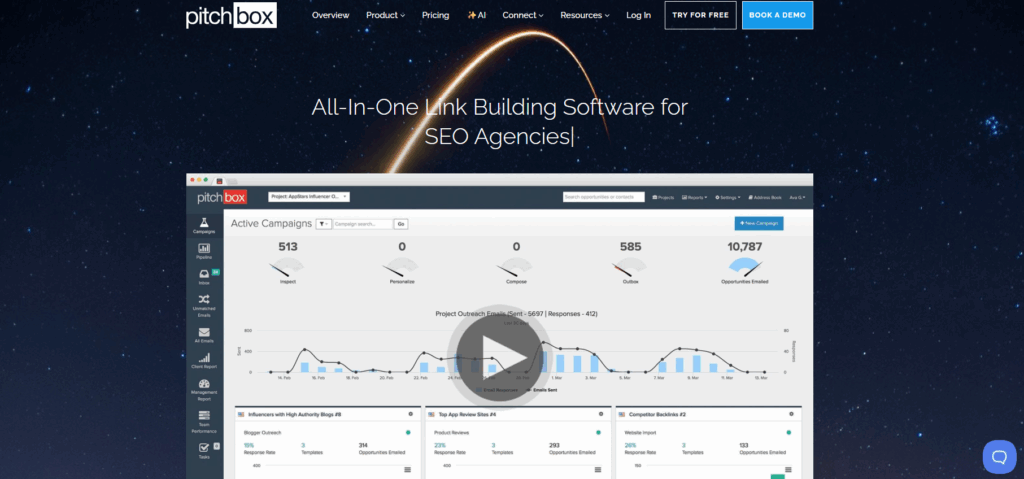
PitchBox is built for precision, crafted to last, and made for professionals who need every moving part to function perfectly. It’s not flashy. It doesn’t try to be clever. But once you’re running campaigns with multiple clients, inboxes, and deadlines, you’ll appreciate just how finely tuned this tool really is.
It’s made for scale, for structure, and for people who want link building to run like a system. If that sounds like you, PitchBox will become essential.
Why PitchBox Works for High-Volume Outreach
Once your list is uploaded, PitchBox handles nearly every step: finding the right contacts, sending personalized emails, following up, and tracking replies. But it’s not just about automation—it’s about structure and visibility across your whole campaign.
Here’s what it handles:
- Email address discovery, with fallback options and accuracy checks.
- Follow-up sequences that change based on whether someone replies or ignores you.
- A clear view of who responded, who didn’t, and what to do next.
- Personalization tools, so your messages feel written, not mass-produced.
- Campaign tracking, inbox health monitoring, and simple reporting.
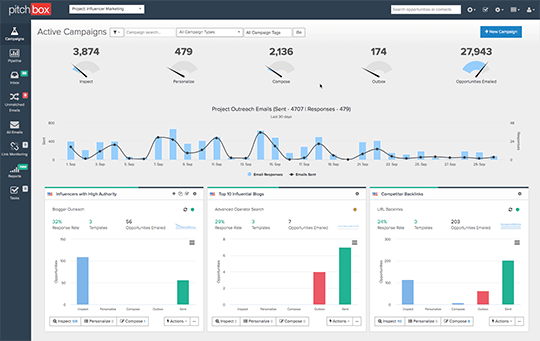
A Clear, Guided Workflow
PitchBox isn’t flexible in the way loose systems are, but that’s exactly the point. It keeps your team organized and your campaign moving in the right order.
Here’s the step-by-step:
- Start with prospecting, either upload a list or pull data from tools like Ahrefs.
- Let PitchBox find contact info, with options to review and adjust manually.
- Build your email sequence using either your own messages or AI-generated suggestions.
- Schedule and send using built-in email warm-up and rotation options.
- Manage replies assign responses, tag them, follow up, or mark as complete.
Smart Personalization, Without Overcomplication
PitchBox doesn’t leave much room for disorganization. It keeps everything in line, from contacts to replies, which is exactly what most SEO teams quietly need but rarely build for themselves.
And on the AI front, they were ahead long before it became trendy. Back in 2022, PitchBox was already generating personalized intros while most outreach still opened with “Dear [First Name]” like it was a breakthrough.
Today, the tool can adjust your templates automatically based on things like site category, domain authority, industry, or even your own custom labels. It also helps sort replies by relevance, so your follow-ups feel more like deal flow than email triage. Everything’s built to help you send smarter emails, not just more of them.
Where PitchBox Has Trade-Offs
No tool is perfect, and PitchBox has its share of limitations:
- The price is high. Starting at €550/month, it’s built for businesses running serious campaigns, not hobby projects.
- Extras cost extra. Connecting to other platforms or expanding your account often requires add-ons, which adds up fast.
- The design isn’t exactly easy on the eyes. It’s functional, but you’ll never hear someone call it “modern.”
Still, if your team is managing real link output, these aren’t problems, they’re just part of the equation.
So, Is PitchBox Right for You?
If you’re only sending a handful of outreach emails each week, something like BuzzStream will likely suit you just fine. It’s lighter, cheaper, and gets the basics done.
But if your work involves managing client SEO with set deliverables, running affiliate sites that need to hit revenue targets, executing agency-scale link campaigns, or handling corporate and PR outreach across multiple brands, then PitchBox is built with your workflow in mind.
It offers structure, visibility, and control, even when you’re juggling a dozen campaigns and an inbox that won’t quit. Pricing starts at €550 per month and increases depending on your needs, but if you’re operating at that level, the time saved and consistency delivered easily justify the cost.
4. BuzzStream (2025): The Toyota Corolla of Outreach Tools 🚗
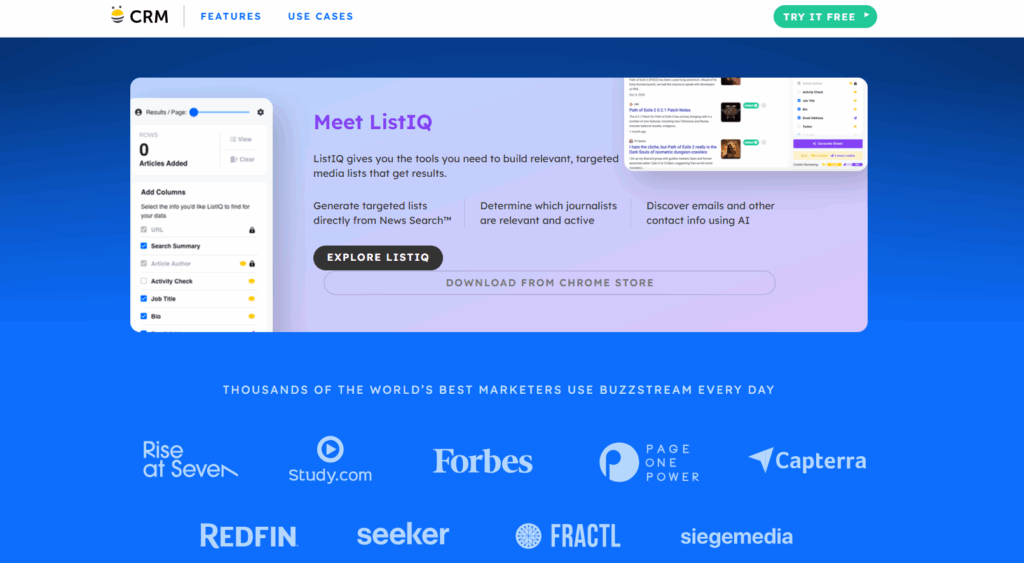
BuzzStream has been in the outreach game for a long time. It’s the Toyota Corolla of link building software – reliable, familiar, and still running smoothly after a decade on the road. It won’t turn heads or win any awards, but it’ll get you where you’re going if you don’t mind the slow lane.
It was the first real upgrade for many link builders moving beyond spreadsheets and guesswork. And while newer tools have since stormed the market with automation, AI, and slick interfaces, BuzzStream quietly keeps doing what it always has: helping solo SEOs manage their contacts without too much chaos.
What BuzzStream Does Fairly Well
If you’re running small campaigns with a personal touch, BuzzStream is a comfortable fit. It’s not flashy or fast, but it’s steady.
You can:
- Keep tabs on who you’ve emailed, when, and what slightly tweaked version of your pitch you used.
- Avoid sending two emails to the same person and looking like your own intern.
- Follow up without having to build a five-step automation sequence that sends one message per lunar phase.
- Keep your prospecting tidy, your inbox sane, and your campaign spreadsheet from turning into a crime scene.
If your weekly outreach involves 20 to 50 carefully written, hands-on emails, BuzzStream functions as a tidy outreach CRM. It’s especially useful for handling niche affiliate deals, coordinating guest contributions, or keeping tabs on partner link agreements.
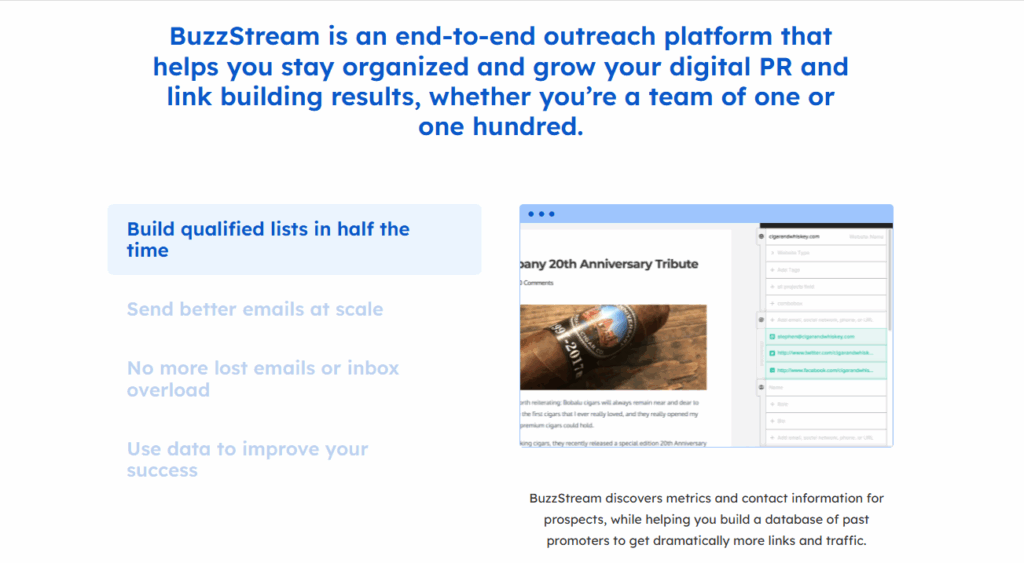
Simplicity Where It Matters
BuzzStream thrives when you don’t need bells or whistles. Just folders, labels, notes, and tidy prospect management.
It lets you:
- Tag contacts by status or role.
- Filter people by outreach stage or opportunity type.
- Store entire conversation histories with each lead.
If your campaigns revolve around one-on-one outreach, guest posts, link swaps, affiliate partnerships, this setup offers a smooth ride. It’s not flashy, but it’s steady enough to keep you in control without veering off course.
Quietly Capable of Link Monitoring
BuzzStream checks if a link is still live, where it points, which anchor was used, and when it first appeared. It logs it all alongside your communication history so that follow-ups feel like continuity, not cold restarts.
It’s not glamorous, but in BuzzStream’s world, being dependable beats being dazzling.
Where BuzzStream Feels Outdated
BuzzStream hasn’t tried to keep up with the modern wave of outreach platforms. For some, that’s a feature. For most, it’s a limitation.
- Manual to a Fault
BuzzStream expects you to do most of the work yourself. It has basic sequencing tools, but they feel more like reminders than automation. If you’re hoping for set-it-and-forget-it outreach, this isn’t the place. - No Help from the Machines
There’s no AI here to speed things along. You’ll be writing intros by hand, choosing subject lines from scratch, and handling every detail one field at a time. It’s all human effort, all the time. - Interface from Another Era
The layout is functional, but the experience is stiff. Navigating between records can feel more like filling out office forms than working inside a modern outreach tool. - Not Built for Shared Desks
Bring more than one user into the mix and BuzzStream starts to wobble. Shared inboxes clash, permissions blur, and the whole thing becomes hard to manage without stepping on each other’s toes.
So, Who’s It For in 2025?
BuzzStream leans toward a manual, no-frills approach.
Email sequences exist, but they’re basic, ideal for users who prefer staying close to the outreach process rather than automating everything.
There’s no AI support for intros or personalisation, but some may find comfort in crafting each message by hand.
The interface is structured and familiar, though not particularly fast or modern.
While it’s not built for large teams, it holds up well for solo users managing focused campaigns.
Shared access and permissions can get messy beyond a couple of people. Pricing starts at €24/month, though most functional setups land closer to €125. For individuals who value control and simplicity over speed or scale, BuzzStream remains a steady, dependable option.
5. Hunter.io (2025): The Bloodhound of Contact Data 🐶
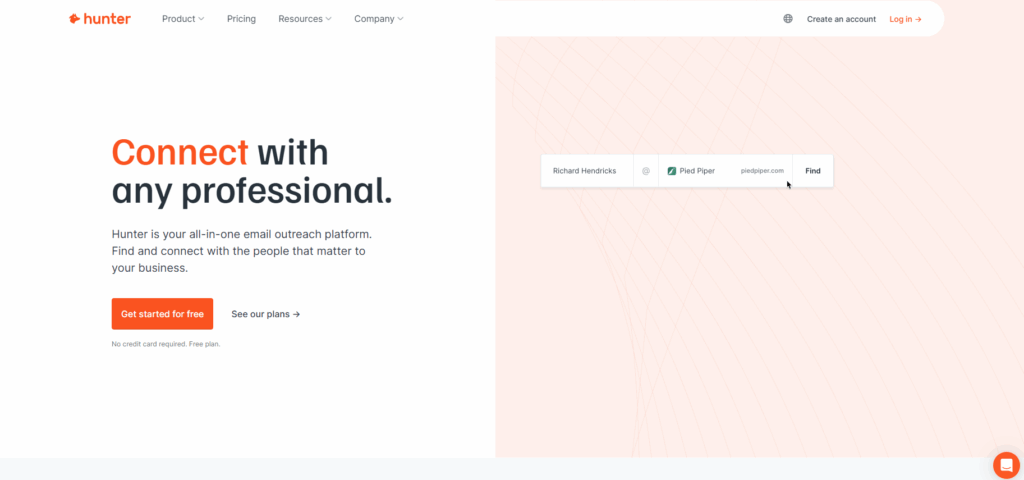
Hunter.io isn’t the loudest tool in your stack, but it’s probably the most essential. While others promise to write, schedule, and optimise your outreach until it glows, Hunter sticks to one job: finding verified contact information and doing it better than anything else.
It’s the reliable utility vehicle that lives in your garage, used daily, bragged about never, but irreplaceable when it matters. Without it, your campaigns start with guesswork. With it, they start with confidence.
Why Hunter Matters in 2025
Outreach has changed. Gmail is pickier, LinkedIn hides more than it shows, and even your old spreadsheet of contacts from 2022 is probably half-dead.
That’s where Hunter thrives. It cuts through closed doors and missing “About” pages to deliver exactly what you need: names, job titles, and email addresses that still work. It’s precise, quick, and constantly updated. There’s no fluff and no patience required.
If your workflow includes:
- Guest post outreach
- Digital PR
- Cold pitching for backlinks or mentions
- Affiliate or partnership prospecting
- Agency lead generation
- Or just trying to reach a real human being on the other end of a “Contact Us” page…
…Hunter is the tool that gets you there faster, and with fewer dead ends.
Here’s What It Actually Does
You give Hunter a domain. It gives you a list of people who work there and the best guess, based on live data, patterns, and verification signals, of how to reach them.
It doesn’t just show you one address and wish you luck. It surfaces multiple formats, adds public sources when available, and gives you a confidence score so you know what’s worth using. You can search by domain, by person, or upload in bulk when building a list at scale.
The €99/month plan allows for 5,000 searches and 250 verifications – a sweet spot for most link builders and PR teams. Plans scale based on volume, starting free (25 monthly searches) and topping out at €399 for enterprise users.
The Secret Sauce: Email Verifier
This is where Hunter quietly protects your campaigns from disaster. The Email Verifier checks deliverability and reduces bounce risk, so you’re not blasting invalid inboxes or tripping spam filters.
It scans DNS records, checks MX configurations, analyses response behaviour, and weeds out anything suspicious, all before you ever hit send.
Think of it like quality control for your lead list.
The Outreach Suite: Good, Not Great
Hunter also includes a basic outreach system: email templates, follow-ups, scheduling, even custom tracking domains. It’s fine if you need something lightweight and integrated.
But if you’re already using PitchBox, BuzzStream, or even just a polished Gmail + GMass setup, this part probably won’t replace your current system. Think of it more as a convenience feature than a selling point.
So, Is Hunter Worth It?
Hunter.io doesn’t bark for attention. It’s the quiet one in your stack, nose down, focused, and always bringing back something useful. It won’t help you write a pitch or follow up, but it will lead you straight to the inboxes that matter.
If you’re tired of chasing leads through contact forms or stale LinkedIn profiles, this tool keeps the trail short. It works fast, doesn’t need hand-holding, and gets better the more you use it.
Plans start free, with paid tiers from €49 to €399. Most settle around €99, which gives you enough firepower for ongoing outreach without waste.
Hunter doesn’t make a fuss. It just finds what you’re looking for, and makes sure it’s real.
Build the Stack That Does the Job
Link building tools don’t win the campaign. The right combination does.
No single platform is going to carry your entire outreach process from prospecting to reporting. What you need is a working stack, a set of tools that handles your weak spots without making a mess of everything else. Choosing isn’t about what looks shiny, it’s about what gets you unstuck.
So before you start adding subscriptions like you’re building a trading card deck, ask: what’s actually broken?
Here’s a breakdown that helps you plug the right tool into the right gap:
| Bottleneck | What You’re Dealing With | Recommended Fix |
| Can’t find contacts | You’ve scraped the web dry, still no verified emails | Hunter.io – Fast, clean, and reliable |
| Manual outreach is exhausting | Too many emails, no follow-up, and inbox chaos | PitchBox – Handles scale with structure |
| Clients want solid backlinks | You need placements that are clean, relevant, and not from a link farm | BuzzStream – Great for 1:1 outreach and link hygiene |
| Deadline’s close, inbox is empty | You’re flying solo and can’t juggle five tools at once | SEMRush – Combines research, email, and tracking |
| Don’t know where to start | You’re guessing what links even matter | Ahrefs – Deep data for smart prioritization |
Each tool solves a problem. Stack only what solves yours. Everything else is just overhead.
Link Building Tools Don’t Send Emails, You Do
None of these link building tools will do the heavy lifting for you. They won’t fix weak pitches, lazy outreach, or a site that looks like it skipped a decade. But combine the right stack with a clear strategy and a steady workflow? Now we’re talking.
Start with one research base, preferably with Ahrefs or SEMrush.
Pick an outreach tool that suits your rhythm, like PitchBox for precision or BuzzStream if you prefer it simple.
Use Hunter.io to find the right inbox, not just any inbox.
Layer in consistency, track what matters, and let the system do its job.
There is no need for guessing anymore. You’re executing now.
And as long as you stay organized and focused, your competitors will be left wondering how you’re always one step ahead. Also, Link Juice Club can always help you create link building strategies that can improve the visibility of your brand; so, you can count on us at all times!
The bottom line is: it’s not about tools replacing you. It’s about tools empowering you to build better, faster, smarter.





